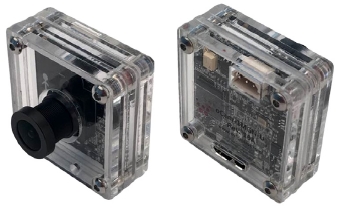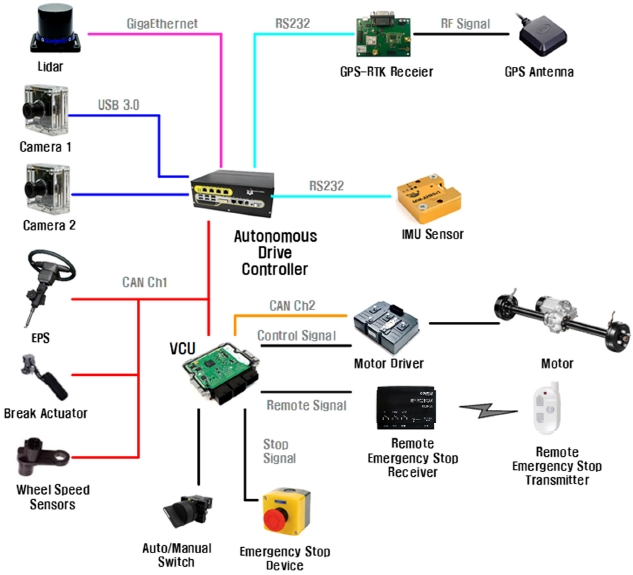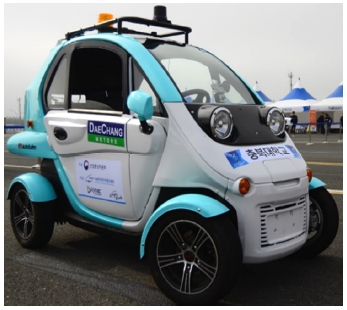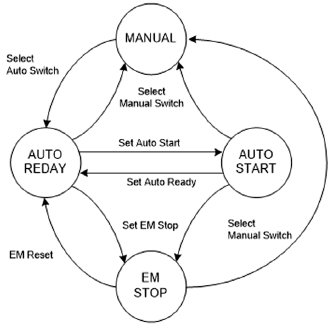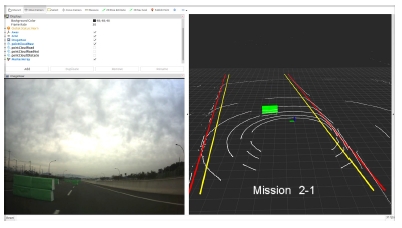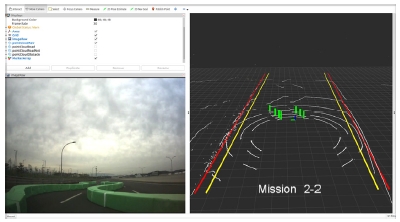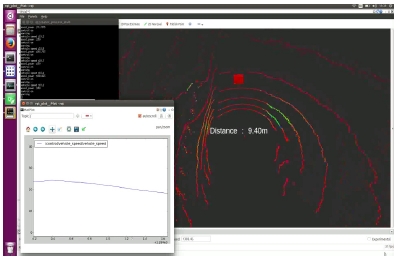
초소형 전기차를 이용한 개방형 자율주행 플랫폼 개발
*This is an Open-Access article distributed under the terms of the Creative Commons Attribution Non-Commercial License(http://creativecommons.org/licenses/by-nc/3.0) which permits unrestricted non-commercial use, distribution, and reproduction in any medium provided the original work is properly cited.
Abstract
Future automobiles are being developed with the fusion of autonomous driving technology and environmentally friendly electric vehicles. For an autonomous vehicle to successfully drive on its own, it is necessary for the vehicle to create a driving path and recognize the surrounding environment by using sensor information, such as LiDAR, GPS, and camera, and to ensure that the vehicle is able to travel safely to its target point. In this paper, we have developed a hardware platform that can run autonomously by using a micro electric vehicle, and we have installed a VCU to control the vehicle. By releasing the CAN interface information from the developed micro electric vehicle-based autonomous driving platform, we are able to share intelligent vehicle development methods and propose them as research reference.
Keywords:
Open platform, Lidar, Vision sensor, GPS, VCU, Autonomous vehicle, Electric vehicle키워드:
개방형 플랫폼, 라이다, 비전센서, 위성항법 시스템, 차량 제어 장치, 자율주행 자동차, 전기자동차1. 서 론
자율주행 자동차에 대한 연구개발은 운전자의 편의성을 극대화 할 수 있는 지능형 자동차 기술로 발전하고 있다. 이에 따라 최근 전세계적으로 많은 국가 및 글로벌 기업들이 무인자동차에 대한 연구를 활발히 진행하고 있다.1-3)
또한 탄소배출에 따른 대기 오염에 대한 환경 규제가 강화되어가고 있고, 이에 따라 친환경 차인 전기차에 대한 관심이 높아지고 있는 추세이다.
현재 대도시의 많은 근로자가 개인용 차량을 이용하고 있고, 이 중에서 80 %는 100 km 이내의 근거리를 이동한다. 개인용 차량은 대부분 1~2인이 탑승하고 있고, 도심의 유동인구 및 차량의 증가로 교통 혼잡이 증대되고, 주차장 효율성을 획기적으로 향상 시키는 새로운 이동수단의 필요성이 제기 된다.
이에 따라 1~2인승용 초소형 전기자동차 또한 국내외 여러 기업들에 의해 개발 및 출시가 진행되고 있다. 초소형 전기차는 일반 전기자동차에 비해 충전시간이 짧고, 유지 비용 또한 낮아 최근 대중의 관심이 더욱 높아지고 있다.4-9)
본 논문에서는 대창모터스에서 개발한 초소형 전기차 다니고를 이용하여, 자율주행이 가능한 플랫폼으로 개조 및 개발을 진행하였다. 상용 초소형 전기자동차에 자율주행에 필요한 환경 인지 및 위치인식을 위한 여러 센서들을 장착하였고, 차량내의 여러 ECU(Electronic control unit)를 제어하기 위한 VCU(Vehicle Control Unit)를 장착하였다. 본 논문은 2장에서 연구개발에 사용된 초소형 전기차에 대한 소개와 구성, 3장은 주행환경 인지를 위한 센서구성, 4장은 자율주행 플랫폼 전체 전장 구성, VCU 정보 및 CAN ID 구성에 대한 내용을 담고 있다. 5장에서는 하드웨어 검증 및 기본적인 자율주행 테스트를 진행하였고, 이를 통해 구성 된 자율주행 플랫폼의 CAN 통신 정보 완전 공개하여 개방형 플랫폼 형태의 자율주행 연구용 참조 차량을 제공하고자 한다.
2. 초소형 전기차(다니고)
자율주행자동차에 사용된 초소형 전기차 다니고는 배터리를 포함한 총 중량 450 kg 및 1충전 최대 주행거리 100 km, 최고 속도 80 km/h를 가진 2인승 차량이다. 초소형 전기차 다니고는 국토교통부로부터 유럽 자동차 안전 기준 ‘L7(초소형 전기차)’평가를 통과하였고, 국내 도로 주행 자격을 갖춘 차량이다. 초소형 전기차 다니고의 상세 스팩은 아래 Table 1, 2와 같다.10)
3. 자율주행차 센서 구성
자율주행차량이 주행에 필요한 외부 환경 인지 및 위치 인식을 위하여 차량 내, 외부에 각종 센서들을 장착하였다. 장착 된 센서들을 이용하여 차선 인식, 장애물 인식, 차량의 위치 및 자세 정보, 주행 경로 등을 파악할 수 있다.
3.1 비전 센서
자율주행차에 장착된 비전센서(카메라)는 차선, 장애물, 신호등을 인식하기 위해 사용된다. 본 자율주행차량에 사용된 비전센서는 Fig. 1과 같은 위드로봇 회사의 oCam–1CGN–U를 사용하였다.
oCam-1CGN-U는 OnSemi AR0134 CMOS image sensor, 표준 M12렌즈를 사용하고 있다. 내부 카메라 제어로 Gain, White Balance Blue, White Balance Red, Exposure 등을 지원한다. 윈도우7/8/10 및 Linux를 모두 지원하고 있어 다양한 환경에서 사용이 용이하다.
또한 다용도의 비젼 처리에 적합한 1 메가픽셀의 글로벌 셔터 컬러 카메라로 USB 3.0을 통해 고속전송이 가능하며 UVC 호환으로 특별한 드라이버를 설치하지 않고 폭넓은 사용 환경에서 사용될 수 있다.
3.2 Lidar
Quanergy M8 LiDAR 센서는 5~30 Hz의 속도로 회전 할 수 있는 8채널의 2D라인 스캐너로 구성되어 있다. 8채널의 레이저는 20도의 Field of view(FOV)를 가지며 전체 장치는 360도의 회전을 한다. 센서를 사용 가능하게 하기 위해 ROS기반의 대이터 기록 SDK와 응용 프로그램을 제공한다. M8의 사양은 Table 3에 나오며, 사진은 Fig. 2에서 확인할 수 있다.
3.3 GPS (Global Positioning System)
차량의 위치정보를 획득하기 위한 GPS모듈은 Ublox사의 C94-M8P를 사용하였다. C94-M8P는 Rover와 Base Station의 개념을 RTK 기술을 사용하여 구성하도록 하였다. Base Station로부터 데이터 스트림을 사용함으로써, Rover는 차량에서 사용 가능한 높은 수준의 정확도로 상대 위치를 출력할 수 있다.
3.4 IMU (Inertial Measurement Unit)
자율주행차의 자세변화 및 주행정보를 위한 IMU 센서는 NTREX사의 NT-ARSv2를 사용하였다. NT-ARSv2 3축 가속도센서와 2축 자이로센서 데이터를 사용하여 6개의 위치와 자세정보(x, y, z, roll, pitch, yaw)중 Roll과 Pitch각을 구하는 ARS(Attitude Reference System)모듈이다. NT-ARSv2는 RS-232와 CAN 통신 인터페이스를 지원한다. 자세한 스펙은 Table 4에서 확인할 수 있다.
4. 자율주행 전기차 플랫폼 및 VCU
4.1 자율주행 전기차 플랫폼
3장에서 소개한 주행환경 인지를 위한 센서 및 차량의 제어 및 주행에 필요한 VCU를 탑재하여 자율주행이 가능하도록 차량 전장을 구성하였다. 차량의 주행에 필요한 3가지 모드(Auto, Manual, Reset)설정 스위치가 있고, 자율주행모드 중에 발생하는 돌발상황에 대비하기 위한 차량내・외부에비상정지장치 및 원격비상정지 수신기가 장착되어있다. 초소형 전기자동차 자율주행 플랫폼 전장구성은 Fig. 3에서 볼 수 있다.
자율주행제어기는 센서로부터 획득한 주행환경 정보를 이용하여, 자율주행 경로 계획을 수립하게 된다. 이를 통해 자율주행 제어기는 VCU, EPS(Electronic Power Steering), Break Actuator 등으로 CAN 통신을 통해 제어를 할 수 있다.
Fig. 4는 개발된 초소형 전기차를 이용한 개방형 자율주행 플랫폼이다. 제안하는 자율주행 플랫폼은 산업부가 지원하는 2017년 대학생 자율주행 경진대회에 참가한 8개 대학에 지원되어 구현된 성능을 모두 검증하였다.
4.2 VCU
VCU는 자율주행을 위한 초소형 전기차 차량 내 ECU 및 각종 장치들을 인터페이스 하는 차량제어장치로 상위제어기(자율주행제어기)로부터 CAN 통신을 통해 제어 명령을 받아 차량내 장치들을 제어하는 Unit이다. 자율주행 초소형 전기차 플랫폼의 CAN ID 구성은 Table 5와 같다.
탑재 된 VCU는 2개의 모드를 가지고 있다. 첫 번째로 수동모드는 기존 차량들과 동일하게 사람이 운전 가능하도록 한 제어 모드이다. 두 번째로 자동모드는 VCU가 자율주행장치로부터 CAN통신을 통해 명령을 받아 주행하는 모드이다. 자동모드는 3개의 State(Auto Start State, Auto Ready State, Emergency Stop State)로 구성되어 있다. Table 6은 VCU 모드 및 State에 대한 상세표이고, Fig. 5는 자동모드의 State 전환 상태를 보여준다.
VCU의 CAN message 16~23 bit 값을 통해 자율주행 제어기에서는 현재 VCU의 스위치 입력 상태를 확인 할 수 있다. Table 7은 현재 차량 내 스위치 입력 상태에 따른 Vehicle Basic State 값에 대한 것이다.
또한 VCU의 24~31 bit는 ECUs TimeOut State로 ECU의 통신연결 상태를 나타낸다. TimeOut State는 Table 8에서 볼 수 있다.
마지막으로 자율주행제어기는 CAN message (CAN ID : 0x220) Request Bit(0~7 bit)를 통해 VCU의 모드 변경 메시지를 전송하게 되는데 해당 Request Bit의 내용은 Table 9에서 볼 수 있다.
5. 센서 융합 및 주행 제어 실험
본 논문에서 제안된 초소형 전기차를 이용한 개방형 자율주행 플랫폼은 2017년 산업부 대학생 자율주행차 경진대회의 공식 플랫폼으로 제공 되었으며, 제공되는 차량에 대한 하드웨어 검증을 위해 완성된 차에 대한 기본적인 실험을 충북대학교 오창 자율주행차 성능시험장 및 대구 지능형자동차부품진흥원 주행시험장에서 진행하였다. 실험에 사용된 자율주행 제어기는 노트북(Intel i7-6700HQ CPU @ 2.6GHz, RAM 16GB)으로 각종 센서로 부터 들어오는 데이터를 바탕으로 ROS 환경에서 센서 융합 및 주행알고리즘을 수행하였다. Fig. 6~8은 장애물 인식, 협로주행, 전방 차량 인식 및 AEB(Autonomous Emergency Brake), ACC(Adaptive Cruise Control) 주행에 대한 결과이다. 장애물 인식은 성능 평가를 위해 총 길이 430 m 길이의 도로에 80개의 장애물을 설치하여 진행하였다. 협로주행은 총 길이 50 m의 구간에 150개의 장애물을 S자 형태로 설치하였다. AEB 및 ACC 테스트를 위해 실험자와 차량의 안전을 위하여 차량모형물을 설치하여 진행하였다. Table 10은 실험 결과에 대한 측정치이다.
6. 결 론
초소형 전기차 다니고를 이용하여 LiDAR, Camera, GPS, IMU 센서와 긴급정지 등의 안전장치 등으로 전장을 구성하였고, 여러 ECU들을 제어하기 위한 VCU를 장착하여 개방형 자율주행 플랫폼 개발을 수행하였다. 개발된 초소형 전기차 기반의 개방형 자율주행 플랫폼에 대한 기본적인 센서 및 주행 테스트를 수행하여 하드웨어 검증을 하였다. 그리고 이 자율주행 플랫폼을 2017년 대학생 자율주행경진대회에 참가한 8팀에 대회용 플랫폼으로 제공하였다.
본 초소형 전기차 기반 개방형 자율주행 플랫폼을 이용하여 누구나 센서를 위한 인지 알고리즘 및 차량 제어 알고리즘을 통해 자율주행차 연구개발을 진행할 수 있을 것으로 기대된다.
Acknowledgments
A part of this paper was presented at the KSAE 2017 Fall Conference and Exhibition
이 논문은 2016년도 정부(과학기술정보통신부)의 재원으로 정보통신기술진행센터의 지원을 받아 수행된 연구임(No. R7117-16-0164, (광역주행-총괄/1세부) 차량 통신 기반의 광역 주행환경인지 및 협조 주행기술 개발).
References
- H. Lee, D. Lee, H. Yoon, I. Song, K. Yun, and S. Kee, “Development of Compact Electric Vehicle Platform for Autonomous Driving”, KSAE Fall Conference Proceedings, p763-768, (2017).
- H. Kim, M. Heo, S. Han, S. Lee, and J. Lee, “A Study on Recognition Algorithm for Unmanned Autonomous Vehicle”, KSAE Fall Conference Proceedings, p790-791, (2017).
-
J. Kim, J. Min, K. Kwak, and K. Bae, “Traversable Region Detection Based on a Lateral Slope Feature for Autonomous Driving of UGVs”, Journal of Institute of Control Robotics and Systems, Vol.23(No.2), p67-75, (2017).
[https://doi.org/10.5302/j.icros.2017.16.0204]

- I. Kim, K. Yang, J. Yun, and S. Hwang, “Development of Path Plan Algorithm and Electric Vehicle Platform for Autonomous Driving”, KSAE Annual Conference Proceedings, p1772-1775, (2013).
- Y. Son, “The Necessity of Electric Cars in Korea and Status of Technology Development”, The Magazine of the IEEE, Vol.42(No.9), p29-37, (2015).
-
S. Yang, N. Jeong, K. Kim, S. Choi, W. Maosen, H. Kim, and M. Suh, “Development of Urban Driving Cycle for Performance Evaluation of Electric Vehicles Part I : Development of Driving Cycle”, Transactions of KSAE, Vol.22(No.7), p117-126, (2014).
[https://doi.org/10.7467/ksae.2014.22.7.117]

-
T. Lee, S. Kim, and Y. Ko, “A Study on the Control Algorithm of VCU for Micro-mobility”, Transactions of KSAE, Vol.26(No.1), p32-41, (2018).
[https://doi.org/10.7467/ksae.2018.26.1.032]

- J. Kim, “Utilization and Prospect of Micro Electric Vehicle for Delivery and Mail Delivery”, Monthly KOTI Magazine on Transport, Vol.238, p42-46, (2017).
- C. Park, “Technology Trends and Developments in Micro Electric Vehicle”, The Korean Institute of Electrical Engineers, Vol.66(No.7), p21-26, (2017).
- DaeChang Motors, Micro Eletronic Car, http://www.dacmotors.co.kr/product/smart-car (2018).

